Monday
Dharma Teachings, Featured StoriesSakyong Gives Talk at Gongter
Sakyong Mipham Rinpoche Addresses Western Students at the Gongter
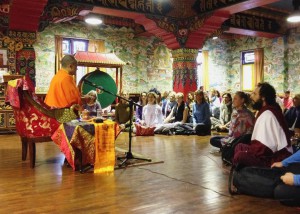 Near the end of the Gongter, Sakyong Mipham Rinpoche gave an evening talk to the Westerners and English-speaking Tibetans attending the empowerments. About two hundred people attended the event, which was followed by a blessing line where everyone had an opportunity to meet the Sakyong personally. It was a magical evening, adorned with a perfectly-timed power failure near the end of the talk.
Near the end of the Gongter, Sakyong Mipham Rinpoche gave an evening talk to the Westerners and English-speaking Tibetans attending the empowerments. About two hundred people attended the event, which was followed by a blessing line where everyone had an opportunity to meet the Sakyong personally. It was a magical evening, adorned with a perfectly-timed power failure near the end of the talk.
Text from talk by the Sakyong:
Sakyong Mipham Rinpoche: Well, we’ve spent twelve days together. I don’t know who’s counting [laughter], but it’s been an extraordinary journey. First of all, I want to express how moved I am that so many of you decided to come. You took this time out of your life and made this journey, a pilgrimage of the mind and heart, to come here. It is commendable to be in a situation like this one. I am have also been very touched by His Eminence, the Venerable Jigme Rinpoche, Lhunpa Tulku Rinpoche, and all the Ripa family. His Eminence has been emotional at times—as emotional as a being like him can get. This is very much the fruition of his life and work. For all of us, coming at this particular time, whether we have been practicing for many years or only just took refuge, it’s a poignant moment.
Karma has brought us together. When we receive the abhisheka there’s a moment when we hold the flower and put it in the mandala. That is a ceremony of karma and inspiration. According to the Buddhist tradition, that ceremony represents that at some time in the past we threw our flower and it landed here. Somehow that moment brought us all here. That is the strength of our mind’s intention, our aspiration and motivation. It is a powerful aspect of the teachings.
We live in a world that is dominated by science and empirical analysis. What we see is real, what we don’t see is not real. However, this whole ceremony has very much been about the unseen, about the mind. And now, even science and modern culture are beginning to recognize that the universe is multilayered. This truth has been understood and experienced throughout the Buddhist tradition and in many other wisdom cultures. What is important is the cultivation of the mind and heart.
Part of what is happening is we are exploring who we are. We are exploring our humanness. We are also exploring our enlightened qualities. One of the basic premises is that innately, the foundation of who we are is awake, enlightened, and complete. That is the notion of essence, and of seed. This sounds very philosophical and theoretical, but the idea of who we are as people—and what human nature is—along with the environment, is one of the most critical issues of our time because we are living in a world where there is more doubt. There is more aggression and cynicism. Many cultures now doubt the spirit of humanity and have very cynical views about religion and spirituality. There are many questions about who we are and how we will go forward. It is definitely a very interesting time.
It is this question of who we are and how we are that leads us on a journey and a path. We are all looking, which is important, and I encourage you continue on your journey after receiving these abhishekas. In a simple way, having a question is also what deity practice is. The deities help us answer that question.
When my father and His Eminence were they were seventeen or eighteen years old and about to escape Tibet, they engaged in the Rinchen Terdzö abhishekas, which are about four months of exactly what we are doing here. His Eminence received those empowerments from my father. With their own spiritual insight they were both wondering what the future is. One of the qualities that I take from both these teachers, from both gentlemen, is this tremendous spirit of bravery and courage. My father went to India, and later to the West, but he entered a situation where nobody knew about Buddhism. It was the late Sixties, just the beginning. Most people didn’t even know where Tibet was. Being alone was not “cool.” [Laughter.] There was a good mixture of activists and hippies. We are very proud of our hippies. It was a time of exploration.
My father continued to teach and explore how the dharma and human wisdom can have relevance in modern times. A basic premise of that exploration is the question of who we are as individuals. This is related with His Eminence receiving these visions of Gesar and the empowerments.
The essence of Gesar is courage and bravery. You can have experience, you can have knowledge, but you have to have bravery and courage to actually go forward. We are all somehow connected to that spirit of bravery. It was brave for you to come here. [Laughter.] Maybe you wondered a few times while the stomach was grumbling. Bravery is important because, by and large, people just get busy with their lives and do not explore the essential and critical issues of human nature and society. However, that is very much what we are doing here. One of the basic elements of this approach is that we are in a culture and tradition that believes that humanity is good, humanity is complete. That teaching is simple, but it is profound.
My father expressed this in many ways. He talked about it as basic goodness dömané sangpo in Tibetan, “primordial goodness.” What does that mean? Most of us, when we reflect, are not sure that we are good or complete. We have a lot of doubt. Not only that, but we are not sure if somebody else is good and complete. It is a simple principle, but it has a profound effect on how we view the world and how we view ourselves. If we do not view ourselves in an intimately healthy way, life becomes a process of guilt, of not feeling satisfied. In such a process, we cannot express love or compassion, we cannot hold others.
Gesar lived at a time when aggression arose and the notion of human goodness and human nature were suppressed. In a sense, his journey was to go out the four directions and manifest in a peaceful way, a magnetizing way, an enriching way, and a wrathful way in order to uplift society. There are many similarities between Gesar’s time and our own. There is a lot of confusion and aggression. We live in a time when we need to look at who we are and how we are going forward. This period when humanity becomes doubtful, depressed, and aggressive, when people treat themselves and others badly, is called the dark age, when the sun sets. Human values are setting, the human spirit is setting, human ethics are setting. Gesar brings about the rising of the sun by reinvigorating the notion of ethics and culture in a simple way. As we explore the themes of enlightenment and compassion, that is part of what we are doing here, asking, “Can we live our life this way?” To me, one of the most important things is that it is not just about understanding this stuff intellectually; it is about actually embodying, manifesting, and living it.
Whether the teachings and blessings of His Eminence and what my father began go forward does not come down to how great they are, but to how much we can manifest and actually live our life. This is challenging. We cannot have compassion, or a sense of love, and just keep it secret. We have to engage. That’s what we are talking about. What inspires me is the question of how can we try these things out in a society that may not particularly agree with our method and says, “That’s your trip, being compassionate, being nice. Go meditate.” How do we actually do this? Tibetan Buddhism is not just an intellectual trip; it is a culture that has produced incredibly human people. That is what has inspired this situation.
Even if we talk about deities, it is important that we don’t do these practices while trying to abandon who we are. This is where the notion of abhisheka comes in. If we have doubts and obstacles, we may become self-centered to the point that we can’t get out of bed and say hello to somebody. We can’t just hold the dharma; we have to manifest it. Even though we understand all the dharma, we can be decent to somebody else.
The tradition of abhisheka ceremony empowers the strength that we all have. It is connected with our own body and mind. The two main words for abhisheka— in Tibetan, wang—are abhishinsha and abhisheka. Abhishinsha has to do with the cleansing process, the calming and purification process. Abhisheka has to do with empowerment. The process of abhisheka is that one is bathed and then enthroned. What’s enthroned is our enlightened qualities. You could say that in many ways we go through empowerment every day, but sometimes it is in reverse. Our aggression is empowered, our self-centeredness is empowered, and then that rises up. It is not about being good or bad, it is about looking at the very, very subtle seeds of who we are.
Abhisheka is a ritualized ceremony where the teacher tries to empower, help, and uplift the student. In order to do that, the student must come forward and want to be bathed and dressed—even with a limited water supply. [Laughter.] Wanting to do this and having some energy for it is what we call faith or devotion. It is what we call lungta, energy. As everybody at Gongter knows at this point, you have to do some searching even just to survive the abhisheka because it can be a very long process. It sounds like a good idea, and after a while you start to wonder if you know what you are doing.
Often there is a time before the abhisheka when you contemplate why you are doing it. It is the same if we are going on a journey. We need reasons to go on a journey because there may be challenges. We have to remind ourselves why we chose to go. That is normal. We go through that same process during different situations every day.
The abhisheka process is pointing to our inherent strength, which is being purified and empowered. The process of the abhishekas, which relates to the four elements of body, speech, mind, and wisdom, addresses how our own body, our own speech, our mind, and the inherent wisdom are acknowledged and empowered. Abhisheka is a permission and blessing for us to act on our enlightened quality. What does that mean in a practical way? It means that once we have received abhisheka we have the permission of that particular lineage to do visualization practice and see ourself as enlightened. Part of the quality of visualization and meditation is getting used to those qualities of wakefulness.
The journey we are going through can become esoteric, but also it’s very human and simple. According to the vajrayana teachings, how we relate to our physical body is that the body is precious. Our speech too—the wind and channels—is also very special. Even our thinking mind has inherent wisdom at its root. Nonconceptual wisdom is inherent within us. This is a path that we are traveling.
What happens in powerful situations like this one is that something unnamable, inexpressible, is transmitted and experienced. Ultimately, especially in the vajrayana—[the power goes out] Can you hear me? [Students: Yes.] You’ll have to visualize now. [Laughter.] In the vajrayana tradition especially, nonverbal communication takes place. That is done through the imagery. As we go through the empowerment, we are becoming familiar with symbolism, which is the notion of things being transmitted in a nonverbal and nonconceptual way.
Sometimes we may read a text and intellectually understand it, but when we do the practice, something is not happening. Then we need the missing link, which is some kind of blessing and acknowledgement. This ceremony is empowering your practice and understanding at an immediate level. Not only that, it lays the foundation for your experience and practice in the future—whether that is in a meditation session or not. This is very important to understand.
After the empowerments, when you return home and go back to your life, I hope you will take along what has happened here. It will help you see your life and what you are doing in a fresh way. In particular, I encourage everyone to engage in the principles from these empowerments that are helpful to you and try to help others. Not only is this an incredible way to learn things for yourself, but even simple things we do can be very powerful for other people. We don’t have to feel like we must understand everything or accomplish everything. That is what I mean by the notion of bravery and courage. We are creating the possibility for things to occur. That’s what we are doing here.
In many ways, something important has happened because the transmission of Gesar occurred. Everyone’s experience of this will benefit the world. It is much broader than any of us. This is a very auspicious ceremony and ritual to be involved in. We have all been part of creating the good intention that allowed His Eminence to be able to teach his termas in a full way. This will be incredibly important for the Ripa lineage and all its activities in Russia, Switzerland, France, Spain, and many other places. This has also been an excellent way for the Shambhala community to connect with the Gesar tradition and share this common family root. As you have seen, the whole thing is very family. It is wonderful that it has occurred.
I send you all my blessings and good wishes for how you go forward. I hope you make it the next two days. [Laughter.] Try to stay healthy. I look forward to seeing all of you again and again. Tashi Delek and best wishes. Let’s conclude with a bow.


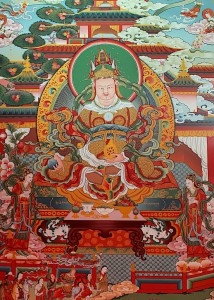
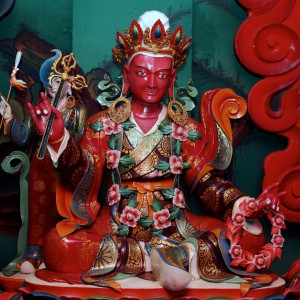
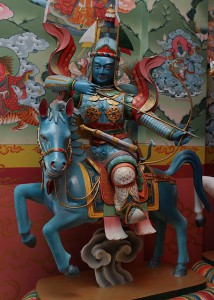
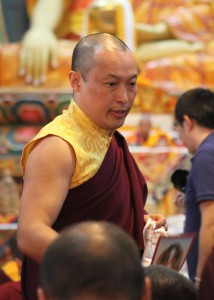




Nov 16, 2015
Reply
Thank you for sharing the teachings Your Majesty! It is so appreciated!